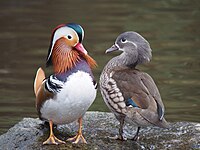
Photo from wikipedia
Abstract Foraging behavior can have population-level effects that are of interest for wildlife management. For invasive species, foraging behavior has been tied to establishment ability and rate of spread and… Click to show full abstract
Abstract Foraging behavior can have population-level effects that are of interest for wildlife management. For invasive species, foraging behavior has been tied to establishment ability and rate of spread and is generally of import in understanding invasion biology. A major method for controlling invasive vertebrates is using food-based baits as attractants. Tool efficacy is therefore partially driven by individual decision-making during foraging, which may also affect population response to control. We used three studies on the invasive, arboreal brown treesnake (Boiga irregularis) on Guam to measure 1) size, body condition, and behavioral correlates with mortality in response to control using toxic baits, 2) shifts in prevalence of those traits after control treatments occurred and, based on the prior two findings, 3) interactive relationships between size, body condition, and behavioral traits at the landscape scale for untreated populations. Each trait was selected due to a potential relationship with foraging behavior or energetic state of an arboreal snake, as a method to estimate how foraging behavior can inform control tool efficacy. We found that snakes were more likely to be killed by toxiic baits if they had a lower body weight, were more active leading up to a bait application, and encountered on the ground more frequently. Across two treated populations, both body size and condition of sampled snakes increased after treatment, while the incidence of ground encounters decreased. Throughout forested habitat on Guam, ground encounter probability was positively correlated with snake size and inversely correlated to body condition. Additionally, size and condition had interactive effects such that snakes in good condition were more arboreal. Thus, body size and behavior (ground encounters) correlated with control-tool susceptibility and frequency shifts occurred in those traits within sampled post-treatment populations. Individual decision-making during foraging may thus inform population responses to bait-based control tools. Management decisions such as prey suppression are likely to directly influence removal efficacy through altered foraging behavior in snakes.
Journal Title: Global Ecology and Conservation
Year Published: 2020
Link to full text (if available)
Share on Social Media: Sign Up to like & get
recommendations!